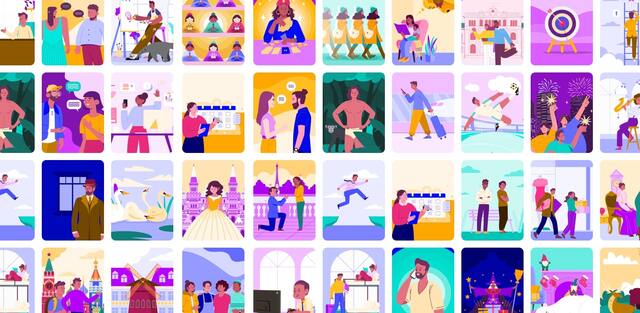Should You Really Learn Two Languages At Once?

A lot of people are intrigued by the idea of learning two languages at once because who doesn’t love killing two birds with one stone?!
Still, a lot of sites actually recommend not studying more than one language at a time unless you’re prepared to learn at a much slower pace.
There’s definitely merit in sticking with only one language unless you’re sure about the work and journey that lay ahead, especially if you don’t speak a second language yet.
But that’s not what I want to talk about here. Instead, a road less traveled is whether it’s a good idea for learning languages better, (and more of them), in the long run.
This one is mostly for anyone with polyglot dreams or anyone who’s uncertain about which language(s) they want to become fluent in.
Allow me to start down this different path.
Content

Fixing Your Mind For Multiple Samples
Learning How To Transfer The Struggle
How Do We Learn Languages In Broad and “Wicked” Ways?
Add Some Range To Your Language Development
Fixing Your Mind For Multiple Samples

I picked up this notion from the incredible book; “Range: Why Generalists Triumph in a specialized world” by David Epstein.
He basically breaks down how most people that are successful in any field start out ‘broad’ with several things on their hands, a “sampling period”, – and that specialized, (narrow focus), learning often isn’t the best way to start learning something new.
Broad and diverse experience is the way to go in the beginning.
While his work is applied on a much wider and comprehensive scale there are connections that suggest trying on multiple languages might actually be hugely beneficial to your language development overall.
On the other hand, many sites and popular polyglots advise against learning more than one language at a time. It’s referred to as “spreading yourself thin” because you’re not able to dedicate the time and focus that each new language requires.
I agree that in order to become fluent you need to do deliberate practice no matter the language – and that’s a lot already.
But there are a few problems in relation to this, especially if you’re a beginner and think, “all these different languages look so appealing, I want to do them all.”
If the case is ‘only-one-at-a-time’ then, what language should you pick? How come polyglots decide on some languages and not others? And don’t they actually practice multiple languages all at once?
This brings us on to “match-quality”

The importance made by David Epstein on “ match-quality” is the fit between interest and ability in any field.
I know a lot of language enthusiasts who dabble between multiple languages. In fact, it seems like almost everyone in the language community does this – and often feel quite guilty for not sticking to ‘just’ one.
But actually, you shouldn’t be feeling too bad about that.
Spreading across several fields, (or languages), will help you find what matches best for you.
It’s not just switching between different languages but also trying out different methods and techniques over multiple categories like reading, writing, speaking, etc.
It’s the development through short-term planning and that’s exactly the point for sampling wide and not specializing in one language.
Keep in mind this is before you’re decided about which language to learn.
The point is, you learn something about several languages, cultures, even yourself.
You can transfer that knowledge to the next language and find a match that will make your practice and learning better.
For example, one of my friends loves languages and everything that revolves around it.
She started learning Spanish, then she added French, then Portuguese and later again Italian which she ended up devoting all her time to.
She later told me that she was able to take parts from Spanish, French, and Portuguese and apply them to Italian. Not only sounds and words but also when it came to her interest and understanding for the people and culture.
The point is she went ‘broad’ to discover her interest but also took new abilities with her in each step until matching it all with Italian.
So what about picking one language and sticking with it? (at least until you’ve reached a conversational level.)
This is where the recommended language path seems to rests a lot on the popular personality trait “grit”.
Grit is about being resilient enough to follow through on your long term goals, (in any part of life), whenever the going gets tough. The idea is that someone with a high grit is more likely to succeed in whatever they take on.
Grit is without a doubt important when you want to learn a new language (see this specifically about disciplined learning strategies.)
The problem is if you bounce from one thing to another that’s seemingly considered the opposite of grit.
How often do you abandon one language before you get past the beginner’s level only to start learning another one?
Before you beat yourself up over not being a member of the pick-and-stick cult, according to David Epstein, match-quality is actually not the opposite of grit.
The two play together in your performance exactly because your practice becomes more dedicated, more resilient, once you find the right fit. Aka the one, you’re more likely to successfully become fluent in.
This doesn’t mean that you should never dig deep into a language when learning it. It’s just that maybe you shouldn’t start out that way.
Learning How To Transfer The Right Stuff

Aside from not having to feel bad about all your multiple language cravings let’s also take a different approach to the way we learn.
Slow and agonizing learning eventually beats quick and exciting learning methods.
“Wait, what are you talking about?”
It’s counterintuitive and sounds unpleasant but progressing fast and easy through the learning curve won’t stick in the long run. (Learning-hacks anyone?)
In “Range” it’s claimed that more often than not if we learn too fast it’s because we’re learning in the wrong way.
Instead, we should seek “Breadth of transfer” – the ability to transfer what you learned in one field over to another.
This also means making your practice broad so that you can transfer useful frameworks rather than conducting repetitive tasks that are unlikely to stick in your long term memory.
An example from the book is of two groups in the military practicing responses to naval threats.
The first group was set to practice a specific scenario over and over. This gave them a feeling that they were progressing fast and improving their skills. They would then move on to the next scenario and repeat the same method.
The other group would never see the same scenario repeated in their practice and as a result, they felt frustrated and didn’t seem like they were progressing at all.
When the teachers later placed the two groups in front of a scenario neither of them had seen before, the second group outperformed the first one by a great deal.
So how does this “transfer-knowledge” fit in the language world?
What’s interesting is how many polyglots and multilingual speakers emphasize not spreading yourself thin.
At the same time, you’ll also find that they claim knowing more languages at the same time transfer onto each new language they learn.
Phrases like, “you should practice all your languages often,” and “once you reach a certain conversation level you can add a new language in the mix,” are quite common to run into.
Famous polyglot, Benny Lewis, even talks about how the most difficult and frustrating way to learn a language eventually got him the best results.
He says, “I learned how to learn”
That goes to say, frameworks are important for future language learning. If you pair that with the notion from “Range”, then dabbling in multiple languages seems like a great way to start your language journey.
But does that mean you should?
Maybe. It depends on how much time you’re willing to invest.
Ironically this short term look of ‘broad sampling’ is actually a precursor to the later deep learning that will serve you in the long term.
For Benny Lewis, learning Spanish took 30 days of full immersion while constantly grappling with difficult situations – and that was just the first stretch. Something we can refer to as a ‘wicked’ environment.
The Kind and The Wicked

It’s the concept that skills and abilities can be placed in “ kind” or “wicked” learning environments.
The starting example from “ Range ” is between Tiger Woods and Roger Federer.
The best in each of their sports but with entirely opposite ways to success.
Tiger started training golf, deliberately, around the age of two. Roger, on the other hand, dabbled in multiple other sports before settling on tennis much later than any of his peers.
It’s the case of broad against specialized, (narrow), focus.
Other than having different paths to success their fields are also different.
Golf is considered a “kind” learning environment in that there are clearly defined boundaries.
The feedback you get from any action you take is instant, accurate and reliable, and the same patterns repeat over and over again.
In short, you can become better by practicing one narrow thing over and over again.
Tennis is less kind and has aspects from the “wicked” end of the spectrum.
While there are rules and boundaries to tennis, it’s a much more unpredictable sport.
Since you play against another person the feedback you get is often misleading and hard to interpret and you likely won’t become better by practicing the same thing simply because you can’t expect the exact same outcome every time.
It’s important to note that “kind” doesn’t equal ‘easy’. It simply means that specific narrow actions are a way to progress and get better.
Now, the question is whether or not language is a “kind” or “wicked” environment?
I’d make the argument that there are both kind and wicked parts to language learning.
For example, grammar provides boundaries and once you learn a new word that meaning is not gonna change in the near future. So you can become better with, (meaningful), repetition.
But there is also the context of different cultures which are huge for understanding and using any language.
How do we learn languages in broad and “wicked” ways?
One of the most effective ways to apply “wicked” practice is by using “ spacing” and “ interleaving.”
Spacing is about taking time out between each study session. You want to let new knowledge, sink to the back of your memory before you repeat the session.
Before you interject with, “if you don’t use it, you lose it.” – it’s not exactly about not using it.
It’s about making your brain work harder to recall information so you’re more likely to remember it compared to doing the same mindless exercise over and over again. Like with the naval threats.
You’ll probably feel really frustrated at first but eventually, you’ll become better at connecting the dots. Similar to how cognitive patterns work in a bilingual brain.
Interleaving is about shuffling your practice so you get diverse topics and exercises.
Doing this forces you to build abstract models like the frameworks mentioned about learning how to learn.
It often involves “ making-connections-questions ”, where you have to draw in different concepts instead of going by fixed procedures.
For example, memorizing grammar rules like these German cases would be considered a repetitive fixed procedure.

Whereas recalling the correct use of the cases by something along;
“How is this connected to the way it’s used in your favorite song and a story on a similar topic?” – sure, it’s a stretch, but you get the point that learning this way is a challenge rather than a routine.
By mixing it up you’ll also end up automatically putting space in between familiar practice.
David Epstein even mentions a study of teaching Spanish that showed 250% better retention when they used spacing.
The Method In Action
Step 1
Sample a broad selection of different exercises and methods of practice.
For example, if you use Beelinguapp, that provides options for practicing reading and listening, vocabulary with flashcards, exploring news stories, playing a game. It could even be something like taking a walk or doing other physical exercises in between to get your brain fired up while also adding more spacing.
Sample enough to have at least a few hours without ever hitting the same exercise.
Step 2
When you’re starting out learning two languages, you’d want to hit as many subskills as possible. Remember it’s about going broad at this point, not digging deep.
Say language ‘A’ is Spanish and language ‘B’ is German.
For example, start with language ‘A‘ and do between 15-20 minutes of reading short stories or bite-sized news stories . Then switch to practicing vocabulary with flashcards for the same amount of time, (make sure to mix up all the categories within your flashcards as well),
Then finally play the ‘Beelinguapp-challenger game’ or another language game for the same amount of time.
Then switch and do the exercises for language ‘B’.
You can pick any kind of practice you prefer but the important thing to remember is that you also mix up your strong and weak parts in each language. So, if you’re better at reading than speaking you’d want to make sure you’re not giving preference to reading just because you have an easier time with that.
Extra Steps
You can alternate language ‘A’ and ‘B’ with a day in between. Or if you really want to use spacing you can do one week of language A, still mixing up the practice, and then do the next week with language B with similar exercises.
Additionally, take some time to study the culture and history of the language you’re learning. It might help you discover a better understanding of the language and evaluate if this is a language you would invest the time to become fluent in.
Add Some ‘Range’ To Your Language Development

This exploitative dive into learning two or even multiple languages at once is starting down a path that could determine your development later on in your language journey. Even if it’s not ‘widely’ recommended.
- Make sure you stay broad and don’t end up digging deep into one language.
- Find the language that fits you the best then start to focus more narrowly on that.
- Mix up your learning techniques so you constantly challenge yourself and feel like learning is frustrating and somewhat a struggle, (you’ll appreciate it later on).
This is a long term strategy that weirdly enough starts out by only looking at the short game.
On Beelinguapp you’ll find 14 different languages to get you started on finding your favorite match today.


